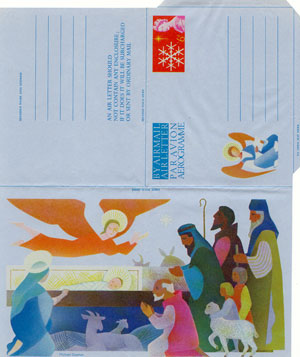Aerogram
Aerogram is a lightweight piece of stationery that folds into its own envelope, typically used for air mail. Originating in the early 20th century, aerograms were designed to optimize postage costs for international mail by reducing the weight of the letter. They became especially popular during and after World War II, serving as an economical means for soldiers and civilians to communicate across long distances.
History[edit | edit source]
The concept of the aerogram can be traced back to the invention of air mail itself. As airplanes began to be used for mail delivery, postal services sought ways to reduce the weight of mail to lower transportation costs. The aerogram, also known as an air letter, was developed as a solution. It was a single sheet of lightweight paper that could be written on and then folded into an envelope shape, sealed, and mailed without the need for an additional envelope.
During World War II, aerograms were widely used by military personnel stationed overseas to send messages home. Known as "V-Mail" in the United States, these aerograms were photographed and transported as microfilm to save space and weight, then reprinted at reduced size and delivered. This process significantly increased the volume of correspondence that could be transported.
Design and Usage[edit | edit source]
The standard aerogram design includes pre-printed postage on the paper, indicating that the cost of mailing is covered. Users write their message on the inside and then fold the aerogram according to the instructions, sealing it with adhesive strips. The address is written on the outside, and because of its prepaid postage, no additional stamps are necessary.
Aerograms must be sent without enclosures, as adding items inside would increase the weight and potentially violate postal regulations. This restriction made aerograms less versatile than traditional letters but also maintained their low cost and efficiency.
Decline[edit | edit source]
With the advent of digital communication technologies, such as email and instant messaging, the use of aerograms has significantly declined. However, they remain a nostalgic and historical form of communication, appreciated by philatelists (stamp collectors) and those interested in the history of postal services.
Collectibility[edit | edit source]
Aerograms are a popular item among philatelists, who collect them for their historical value, unique designs, and the stories they tell about the era in which they were used. Collectors often seek out aerograms from specific countries, time periods, or with rare postage marks.
Conclusion[edit | edit source]
The aerogram represents an important chapter in the history of postal services, reflecting the evolution of mail delivery in response to technological advancements in transportation and communication. While no longer widely used, aerograms remain a symbol of the ingenuity of postal systems to adapt to changing needs and circumstances.
This communication related article is a stub. You can help WikiMD by expanding it.
Search WikiMD
Ad.Tired of being Overweight? Try W8MD's physician weight loss program.
Semaglutide (Ozempic / Wegovy and Tirzepatide (Mounjaro / Zepbound) available.
Advertise on WikiMD
|
WikiMD's Wellness Encyclopedia |
| Let Food Be Thy Medicine Medicine Thy Food - Hippocrates |
Translate this page: - East Asian
中文,
日本,
한국어,
South Asian
हिन्दी,
தமிழ்,
తెలుగు,
Urdu,
ಕನ್ನಡ,
Southeast Asian
Indonesian,
Vietnamese,
Thai,
မြန်မာဘာသာ,
বাংলা
European
español,
Deutsch,
français,
Greek,
português do Brasil,
polski,
română,
русский,
Nederlands,
norsk,
svenska,
suomi,
Italian
Middle Eastern & African
عربى,
Turkish,
Persian,
Hebrew,
Afrikaans,
isiZulu,
Kiswahili,
Other
Bulgarian,
Hungarian,
Czech,
Swedish,
മലയാളം,
मराठी,
ਪੰਜਾਬੀ,
ગુજરાતી,
Portuguese,
Ukrainian
Medical Disclaimer: WikiMD is not a substitute for professional medical advice. The information on WikiMD is provided as an information resource only, may be incorrect, outdated or misleading, and is not to be used or relied on for any diagnostic or treatment purposes. Please consult your health care provider before making any healthcare decisions or for guidance about a specific medical condition. WikiMD expressly disclaims responsibility, and shall have no liability, for any damages, loss, injury, or liability whatsoever suffered as a result of your reliance on the information contained in this site. By visiting this site you agree to the foregoing terms and conditions, which may from time to time be changed or supplemented by WikiMD. If you do not agree to the foregoing terms and conditions, you should not enter or use this site. See full disclaimer.
Credits:Most images are courtesy of Wikimedia commons, and templates Wikipedia, licensed under CC BY SA or similar.
Contributors: Prab R. Tumpati, MD


